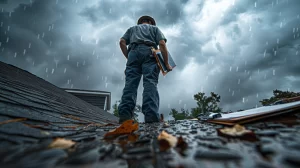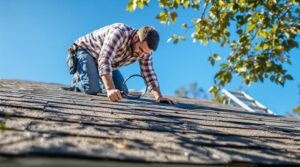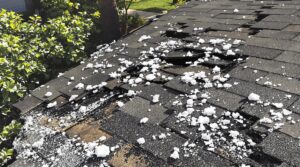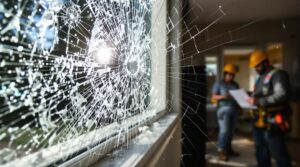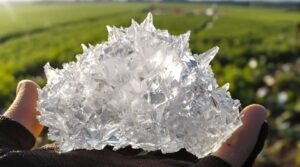Effective hail protection requires strategic preparation and rapid response protocols. Key safety measures include monitoring weather forecasts, securing windows/doors, and identifying shelter locations before storms hit. During hailstorms, individuals should immediately seek sturdy buildings, avoid windows, and if driving, safely pull over facing the windshield toward incoming hail. With annual U.S. damages reaching $8-14 billion, understanding thorough protection strategies can greatly reduce personal risk and financial impact.
Key Takeaways
- Monitor weather forecasts regularly and have a communication plan ready for all household members before severe weather strikes.
- Designate safe zones within your home away from windows and exterior walls, preferably in a basement or interior room.
- Park vehicles under covered areas when possible, and bring outdoor furniture inside before storms arrive.
- Close all windows, blinds, and drapes during a hailstorm to prevent injury from broken glass.
- When driving during a hailstorm, pull over safely, angle your vehicle toward the hail, and stay inside until it passes.
Understanding the Dangers of Hail
While hail forms through a relatively simple process of raindrops freezing in cold upper atmospheres, its potential for destruction is significant, causing $8-14 billion in damage annually across the United States.
The scope of these weather events can be extensive, with hail swaths stretching up to 10 miles wide and 100 miles long, particularly in elevated regions where hail formation factors are more conducive.
The severity of hail damage is most pronounced in specific geographic regions, especially "Hail Alley," which extends from Wyoming to Texas.
Texas consistently leads in hail events, recording 529 incidents in 2024, while states like Nebraska average 206 events annually.
The implementation of hail safety equipment becomes essential in these high-risk areas, where a single storm can cause billions in damage, as evidenced by the record-setting 2001 storm that resulted in $2.5 billion in losses.
Understanding these patterns is critical for proper risk assessment and preparation.
Essential Indoor Safety Measures

With hail's destructive potential established, implementing proper indoor safety protocols can greatly reduce the risk of injury and property damage.
Indoor preparation begins with a thorough inspection and maintenance of the home's exterior components. Critical measures include clearing eavestroughs of debris, inspecting and repairing roof damage, and removing weak branches near the structure.
Comprehensive indoor safety measures require securing all potential hazards before severe weather strikes. This includes relocating vehicles to covered areas or applying protective covers, storing outdoor furniture in enclosed spaces, and ensuring safety kits are readily accessible.
Windows and doors must be properly secured, with drapes or blinds closed to minimize glass-related injuries from potential breakage.
During hail events, occupants should retreat to safe zones within the structure, preferably in basements or areas not directly beneath the roof.
These designated spaces should be predetermined and communicated to all household members as part of a structured emergency response plan.
Smart Driving Strategies During Hailstorms

Since hailstorms can greatly impair driving conditions and vehicle safety, implementing proper driving strategies becomes crucial for minimizing risk. Vehicle safety measures during hailstorms require immediate action and careful execution.
Drivers should activate hazard lights to enhance visibility and maintain increased following distances from other vehicles. When encountering a hailstorm, the priority shifts to finding appropriate shelter while avoiding bridges and overpasses that can create traffic congestion during emergencies.
Key hailstorm preparedness strategies include:
- Reduce vehicle speed immediately to minimize hailstone impact force
- Seek shelter at nearby structures with protective covering, such as service stations or parking garages
- Position all vehicle occupants away from windows and guarantee they are protected with available materials
- Remain inside the vehicle until the hailstorm passes, then assess damage before resuming travel
Following these protocols helps maintain safety during severe weather conditions while protecting both vehicle occupants and property from potential damage.
Protecting Your Vehicle From Hail Damage

Every vehicle owner can implement effective protective measures against hail damage through strategic preparation and quick-response protocols. Extensive hail protection strategies include monitoring weather forecasts, identifying covered parking locations, and maintaining appropriate insurance coverage for potential damage.
Vehicle damage prevention encompasses multiple layers of protection, from permanent solutions to temporary measures. Primary defenses include utilizing covered parking structures and investing in specialized hail protection systems, such as inflatable car covers or tested protective barriers.
When permanent solutions are unavailable, temporary safeguards like thick blankets, car mats, or corrugated cardboard can provide essential protection for vulnerable vehicle surfaces.
Advanced protection systems offer enhanced security through inflatable technologies and wind-resistant designs. These systems, while requiring initial investment, provide reliable defense against varying hail sizes.
Post-storm protocols should include thorough damage assessment, documentation of impacts, and evaluation of repair options against insurance deductibles to determine the most cost-effective resolution strategy.
Immediate Actions for Outdoor Safety
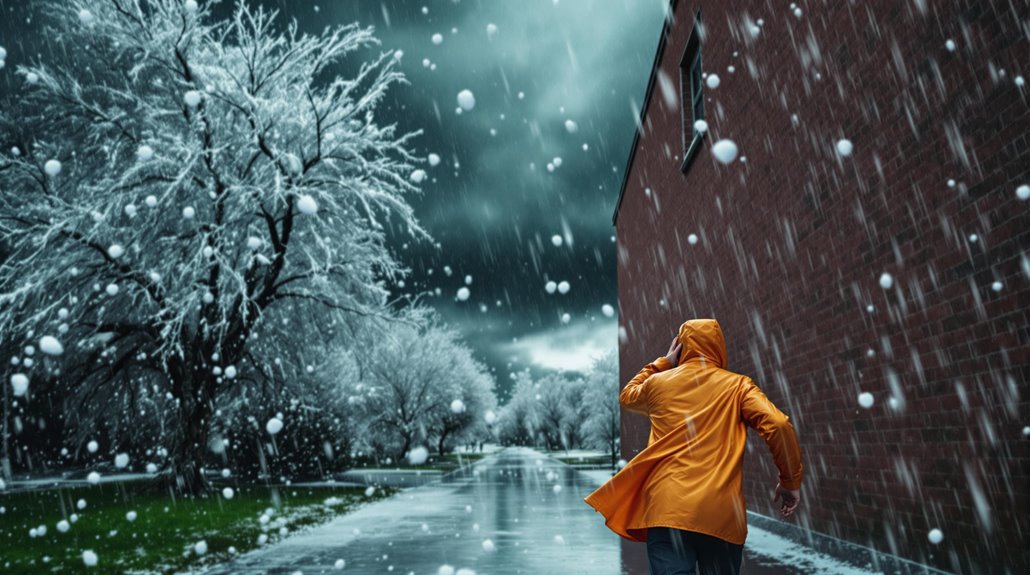
Surviving a hailstorm while outdoors requires immediate, decisive action to prevent injuries from falling ice. Outdoor preparedness and hailstorm awareness are critical factors in minimizing risk during severe weather events.
When caught outside during a hailstorm, individuals must quickly locate and move toward the nearest building with a solid roof structure.
In situations where immediate building access isn't available, protecting the head and neck becomes paramount. Distance from trees and power lines is essential, as these pose additional hazards during severe weather conditions.
Those in open spaces should seek lower ground while avoiding flood-prone areas and culverts.
- Move immediately to the nearest sturdy building or structure
- Shield head and neck with available materials if shelter is inaccessible
- Maintain distance from trees, power lines, and potential sources of flying debris
- Position away from flood-prone areas while monitoring local weather updates
Should outdoor activities be planned, checking weather forecasts and identifying potential shelter locations beforehand greatly enhances safety outcomes during unexpected hailstorms.
Preparing Your Home Before the Storm

Before severe weather strikes, extensive home preparation greatly reduces the risk of hail-related structural damage and personal property loss.
Essential storm proofing techniques include installing UL 2218 Class 4 rated impact-resistant roofing materials and securing perimeter flashing. Regular home maintenance should focus on trimming trees, clearing gutters, and inspecting roof coverings for vulnerabilities.
Window and door protection requires specific attention through the installation of hinged shutters, metal awnings, or hail-resistant films. Proper sealing prevents water intrusion, while closing blinds offers additional protection against broken glass.
Outdoor preparations involve securing or relocating furniture, equipment, and decorative items to prevent projectile damage during storms.
Structural reinforcement should include bracing temporary structures and maintaining readily available protective materials such as tarps, plywood, and duct tape.
Creating a thorough emergency plan with evacuation protocols, backed-up data storage, and an emergency supply kit guarantees ideal readiness for severe weather events.
Understanding your insurance coverage limits is essential when preparing for potential hail damage to your roof and property.
Key Statistics on Hail Impact and Damage

The latest data reveals significant regional variations in hail damage costs, with Minnesota leading at $799 million in claims followed by Texas at $510 million in 2022.
Annual hail-related property damage has shown an upward trend, with total claim costs increasing by $1 billion from 2021 to 2022 and average claim costs rising by nearly $2,000.
State Farm alone processed $3.5 billion in hail claims during 2022, reflecting the substantial financial impact of these weather events on property owners and insurers.
Dollar Impact By Region
Hail storms inflict devastating economic losses across the United States, with annual damage totaling $1.07 billion nationwide.
The regional damage patterns show considerable variation, with Texas experiencing the highest financial implications at $338.6 million annually. Colorado, despite having fewer hail events, sustains substantial losses at $151 million per year, while Oklahoma reports $80.4 million in damages.
- The Great Plains and Midwest regions face the highest frequency of hail events, with Kansas recording 312 incidents annually.
- Insurance coverage varies considerably by state, from 69% in South Dakota to 35% in North Dakota.
- Nebraska endures 206 hail events yearly, resulting in $50.8 million in damages.
- Arkansas experiences 160 annual hail events, leading to $13.9 million in financial losses.
Yearly Property Damage Trends
Recent data reveals an intensifying pattern of hail-related destruction across the United States, with 4,436 documented hail events in 2022 marking an 18% increase from the previous year.
Property value assessment data indicates annual losses averaging between $8-14 billion, with 123 days per year experiencing considerable property damage.
Hail frequency analysis demonstrates substantial regional variations, particularly in "Hail Alley" stretching from Wyoming to Texas.
The impact on properties has been severe, affecting over 6.8 million US properties in 2021 alone.
Insurance claims data from 2017-2019 recorded 2,769,362 hail loss claims, with Personal Property-Homeowners claims constituting 62% of the total.
The average claim severity has increased considerably, showing a 65% rise compared to 2000-2007 levels.
Homeowners can protect against hail damage through dwelling coverage which helps pay for repairs to storm-damaged roofs, siding, and other structural elements.
Emergency Response During a Hailstorm

When a hailstorm strikes, individuals must take immediate protective measures by seeking shelter in the nearest secure building and positioning themselves away from windows, doors, and skylights.
For those caught in vehicles, drivers should pull over safely, ideally positioning their vehicle so the windshield faces the hail, while avoiding areas under trees or overpasses that could create additional hazards.
Those caught outdoors without immediate access to sturdy shelter should crouch down with their back to the wind, protecting their head and neck with their hands until the threat subsides.
Immediate Action Steps
Taking immediate action during a hailstorm can mean the difference between safety and serious injury. Proper hailstorm preparedness requires individuals to assess their surroundings quickly and implement safety protocols based on their location.
Whether indoors, in vehicles, or caught outside, specific measures must be followed to minimize risk of harm from falling hail and potential secondary hazards like broken glass or flooding.
- For indoor safety: Move away from windows and skylights, guarantee all family members are accounted for, and monitor weather updates.
- For vehicle occupants: Seek covered parking, avoid overpasses, and remain inside until the hail stops.
- When caught outdoors: Locate immediate shelter in sturdy buildings, avoid trees and metal structures.
- After securing shelter: Access emergency supplies, stay informed of storm progression, and maintain communication with others.
Shelter Location Decisions
Strategic shelter location decisions play an essential role in guaranteeing survival during severe hailstorms. When selecting shelter locations, ground floor areas away from exterior walls and windows provide ideal protection from wind-borne debris and hail impact.
Shelter accessibility considerations mandate clear pathways and direct access, particularly for individuals with mobility challenges.
Design considerations emphasize the importance of reinforced construction materials and compliance with ICC 500 standards. Shelters should be positioned within 1,000 feet of served buildings and avoid flood-prone areas or basements.
For enhanced safety, integration with the building's overall design guarantees seamless access during emergencies. Critical factors include adequate ventilation systems and reliable communication infrastructure.
The shelter must accommodate the total occupant capacity while maintaining structural integrity according to FEMA P-361 requirements where applicable.
The Benefits Of Consulting A Public Adjuster

Public adjusters provide expert analysis of insurance policies and thorough documentation of hail damage claims, ensuring objective assessments that protect policyholder interests.
Their professional management streamlines the claims process by handling all communications, paperwork, and negotiations with insurance companies.
Statistical evidence indicates that claims handled by public adjusters typically result in considerably higher settlements compared to those processed without professional representation.
Early involvement of licensed public adjusters is crucial for thorough documentation and optimal claim outcomes.
Expertise In Insurance Claims
Professional insurance claim adjusters offer invaluable expertise that can greatly impact the outcome of hail damage claims. Their extensive understanding of policy interpretation and claim strategies guarantees policyholders receive maximum benefits under their coverage.
These specialists possess in-depth knowledge of insurance procedures, documentation requirements, and damage assessment techniques specific to hail-related incidents.
- Analyze policy terms and conditions to identify all applicable coverage options
- Document damage thoroughly using industry-standard assessment methods
- Navigate complex claim procedures while maintaining compliance requirements
- Apply specialized knowledge of construction costs and repair specifications
Public adjusters leverage their technical expertise to evaluate damages accurately, guaranteeing all aspects of the claim are properly documented and presented to insurance carriers.
Their proficiency in policy language and claims processes helps streamline the settlement procedure while maximizing potential compensation for the policyholder.
Unlike insurance company adjusters who prioritize company interests, public adjuster fees are based on a percentage of the final settlement, ensuring their goals align directly with the policyholder's best interests.
Objective Damage Assessment
Obtaining an objective assessment of hail damage requires consulting an independent adjuster who operates without bias toward insurance carriers.
Public adjusters, licensed by the state, work exclusively for policyholders to guarantee fair claim settlements through extensive damage documentation and expert negotiations.
These professionals conduct thorough property inspections to identify both visible and underlying damage that may escape detection during routine assessments. Their expertise in policy interpretation enables accurate evaluation of coverage parameters and depreciation calculations.
Through detailed documentation and systematic analysis, public adjusters compile evidence to support maximum compensation under the policy terms. Their commission-based compensation structure aligns with policyholder interests, while their professional handling of disputes and communications with insurers streamlines the claims process, expediting repairs and settlement outcomes.
Operating on contingency fee basis, public adjusters typically charge 5-20% of the final settlement amount, making their services accessible to most policyholders seeking fair compensation.
Streamlined Claim Process
Engaging a public adjuster greatly streamlines the insurance claim process through efficient documentation and expert negotiations.
These professionals specialize in maximizing claim settlements while reducing policyholder stress through extensive claim documentation and skilled representation. Public adjusters work exclusively for policyholders, guaranteeing their interests are protected throughout the settlement process.
- Professional documentation practices guarantee thorough damage assessment and accurate cost estimation
- Expert insurance negotiations prevent underpayment and address coverage disputes effectively
- Commission-based compensation structure incentivizes ideal settlement outcomes
- Expedited claim resolution through efficient communication channels and industry expertise
Higher Claim Payouts & Settlements
Statistical evidence demonstrates that policyholders who utilize public adjusters receive substantially higher claim settlements, with studies showing increases of up to 747% compared to initial insurance company offers.
This significant disparity stems from public adjusters' specialized expertise in claim negotiation strategies and thorough damage assessment protocols.
Public adjusters employ detailed documentation methods and leverage their understanding of policy provisions to maximize insurance payouts. Their commission-based compensation structure aligns with policyholder interests, ensuring meticulous evaluation of all damage aspects.
These professionals prevent common underpayment issues through expert negotiation and precise scope-of-damage assessments. Their independent status and specialized knowledge in construction and insurance procedures enable them to secure settlements that accurately reflect the full extent of hail damage, averaging 574% higher than self-managed claims.
About The Public Claims Adjusters Network (PCAN)
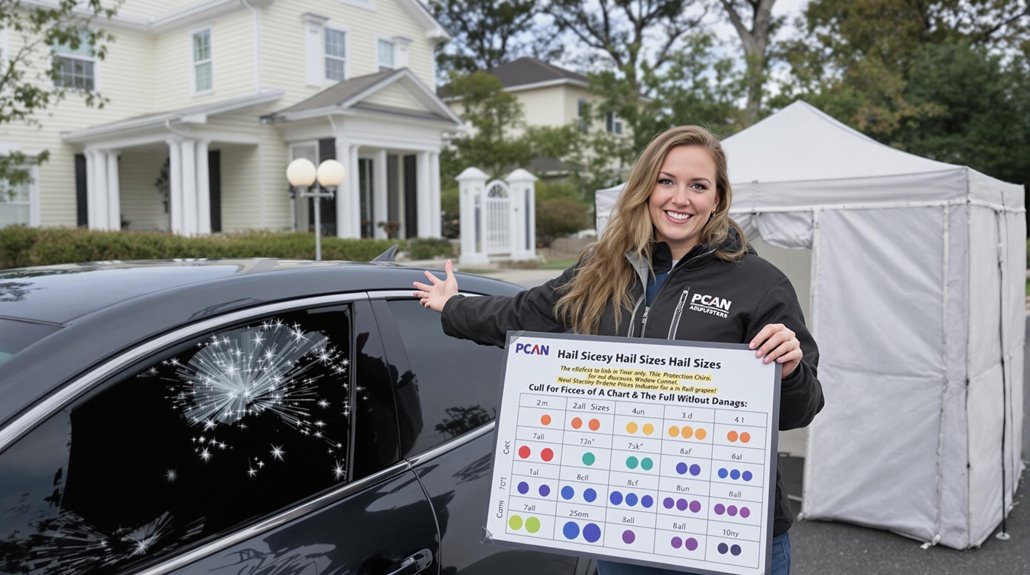
The Public Claims Adjusters Network (PCAN) operates as a professional organization of licensed adjusters who assist policyholders in negotiating insurance claims. These professionals specialize in documenting losses, providing construction estimates, and executing total cost analyses to maximize claim settlements for both residential and commercial clients.
Key public adjuster responsibilities within PCAN include:
- Executing approved contracts with policyholders and notifying insurers within 2 business days
- Managing communication with insurance carriers and presenting settlement offers within 5 business days
- Providing temporary shelter solutions and implementing damage mitigation strategies
- Delivering thorough claims handling through expertise in daily and catastrophic claim management
PCAN members must maintain compliance with Insurance Department regulations, including separate contractual agreements when serving as both adjusters and contractors.
Through their established networks, these professionals leverage extensive experience in claims adjustment while offering immediate assistance through dedicated call center support.
Frequently Asked Questions
How Long Does the Average Hailstorm Typically Last?
While nature's icy barrage varies widely, storm duration typically ranges from 5-10 minutes under typical conditions, though thunderstorms producing hail may persist longer depending on atmospheric stability and updraft strength.
Can Hailstones Become Larger as They Fall From the Sky?
Hailstones can increase in size during descent through storm dynamics that expose them to additional supercooled water droplets, enabling continuous hailstone formation through wet and dry growth processes.
What Temperature Does It Need to Be for Hail to Form?
Like nature's ice factory, hail formation requires cloud temperatures below -20°C, while maintaining specific atmospheric conditions including a freezing level typically under 11,000 feet for ideal development.
Does Home Insurance Automatically Cover All Types of Hail Damage?
Standard insurance policies typically cover hail damage, but exclusions may apply for cosmetic damage, high-risk areas, or specific structural components. Coverage limits and deductibles vary between different policies and insurers.
How Can I Measure Hailstone Size Accurately During a Storm?
Direct measurement of hailstones during storms is unsafe. Instead, experts recommend documenting size post-storm using precise measuring tools or standardized hailstone comparisons to common objects like coins or sports balls.
References
- https://mrcc.geddes.rcac.purdue.edu/living_wx/hail
- https://www.nationwide.com/lc/resources/emergency-preparedness/articles/hail
- https://www.fs.usda.gov/visit/know-before-you-go/hail
- https://www.statefarm.com/simple-insights/residence/staying-safe-in-a-hailstorm
- https://globalfutures.asu.edu/azclimate/weather-safety/
- https://ezautospa.com/25122/hail-damage-statistics/
- https://insurify.com/car-insurance/insights/states-most-vulnerable-to-hail-damage/
- https://blog.cinfin.com/2019/04/09/storm-prep-hail-safety-reduce-damage/
- https://hazards.fema.gov/nri/hail
- https://www.nicb.org/news/news-releases/top-5-states-hail-claims-2017-2019-data

